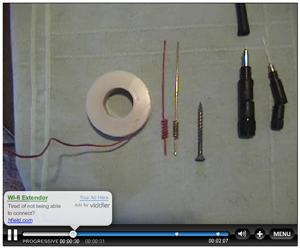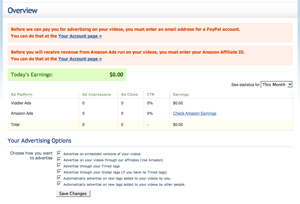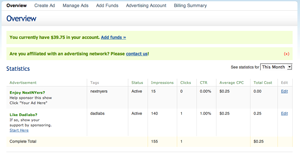This past Thursday, Viddler launched an advertising system that lets companies and individuals overlay advertisements at variously tagged points within the videos it hosts. The system is very similar to Google Adwords, except advertisements are within videos instead of search results, and advertisers sponsor tags instead of search terms.
Viddler’s embeddable player has always been unique in providing content producers and viewers with the ability to place comments and tags at various points within a video. If something is funny at the 1:39 mark, you can submit the comment “lol” and it will show up as a discreet overlay at that particular time during playback. Similarly, you can tag a video during playback with “bicycle” at a point where there’s someone riding a bike. As with other video services, you can also submit tags that describe videos as a whole, rather than just particular points within a video.
While CEO Robert Sandie says that these metadata features were not developed with monetization in mind, Viddler now provides a way for advertisers to run campaigns that take advantage of both global and timed tags (the former being tags that describe videos as a whole, and the latter being tags that describe points within a video). Anyone can advertise through this system by participating in a bidding process akin to Google Adwords. Viddler has also partnered up with Amazon, and is talking with the likes of Buy.com and Shopping.com, to serve up ads for products sold by those online retailers.
The bidding process involves the choice of particular keywords through which you want to advertise. It also involves the highest CPC (cost per click) that you are willing to pay for each keyword. If you are willing to pay more per click than anyone else who wants a particular keyword, you practically own that keyword, and your advertisement will show up as an overlay in any video hosted by Viddler that has been tagged with it. This will remain the case until someone else outbids your maximum bid threshold. Viddler will email you if this happens so you can up the ante if desired. As for Amazon, its advertisements will automatically show up as overlays for tags that have not already been claimed by bidders.
A note on so-called global tags: while the placement of advertisements for timed tags naturally occur at their respective spots during playback, advertisements for global tags show up 1/4 the way through videos. They are also represented as green dots in the timeline, whereas advertisements for timed tags appear black (and regular comments show up white).
Viddler has decided to split revenues 50/50 with content producers, and it has given them a good deal of flexibility regarding the service as well. Producers can opt out of the advertising system completely or sign up for multiple levels of deployment. For example, you can deem that only advertisements from bidders can be displayed, and only through timed tags that you as a producer have created. Or you can allow Amazon to advertise as well, and through tags that your viewers create in addition to your own. For bidders’ advertisements, you will only receive money when your viewers actually click on them (not just view them); and for Amazon’s ads, you’ll only receive money when your viewers actually end up buying something from them.
If you currently publish videos on Viddler, you can set up advertisements by first going to the “Revenue” section and clicking “Enable Revenue Share”. You’ll then have to provide a PayPal account email address and/or an Amazon Affiliate ID to get paid. From this revenue section, you can also manage the tags on your videos and track how many impressions and clicks you’ve experienced for each. You can also set the advertising preferences that will apply to all of your videos (per video settings are not yet available). Advertisers who want to bid on keywords can do so here.
Viddler’s new advertising system can be compared to Google’s Adsense for Video, which has yet to be rolled out fully on YouTube, or any other video sharing service for that matter. As you can see on YouTube’s advertising page, Google plans to deploy animated flash overlays and run video commercials once those overlays are clicked on.
Below is a demonstration video by iJustine for Viddler’s new ad service:



